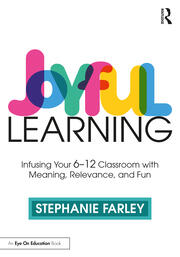Barricade Yourself from Burnout Starting Now
By Stephanie Farley

She’s a lovely kid who will do meaningful work. Occasionally I ask her what’s on young teachers’ minds; not only does she have access to people through her work, but she has TikTok! She told me that burnout is a concern, but that she’s neither seen nor heard solutions.
I met another young teacher who shared that the professional development topic he and his colleagues are most interested in is preventing burnout. Emboldened by this field research – and in the interest of retaining the wonderful young people who’ve joined the education profession – I’d like to offer a few thoughts about how one might avoid or at least soften the sense of emotional exhaustion that leads to burnout.
Enlist Your Principal’s Support
Educational research suggests that feeling supported by your principal is one of the best ways to get through the first years of teaching while retaining your emotional equilibrium. Therefore, find an administrator who can help you plan ambitious projects, provide resources, secure the professional development that’ll help you execute those ambitious projects, and, most importantly, help you figure out a solution when something goes awry (as it always will).
It might not be the principal. My first year of teaching, I carpooled to school with my department chair. On the rides home from school, he kindly listened as I shared the drama that had befallen me that day. His generous and patient counsel enabled me to make it through that humbling first year with my joy intact, and he helped me build out a civil rights curriculum, find appropriate reading material for my 7th graders, and manage grading time.
Sidebar: the first time I graded final exams, I was so confident I could knock them out in a few hours, I started the process the night before grades were due. I stayed up all night to finish on time.
I don’t mean to sound blithe here; I recognize that not all new teachers get to carpool with a mentor! It is important, though, to find a colleague who can guide you, and it’s even more terrific if the mentor is someone who can access the resources you’ll need and who knows you well enough to allow you grace when you (inevitably) miss a detail.
Construct Positive Emotions in Your Classroom, Every Day
As teachers, we are the architects of students’ experiences in our classroom. That’s part of what makes teaching so awesome! Lean into joy – for the students and for you – by starting each lesson with positive emotions, which research tells us improves attention, engagement, resilience, connection, and sense of well-being. You can build a series of framing activities over time, but consider the following to give you a start:
✦ Hand the students stickers with words on them that provide clues to the day’s lesson. Each student can have a moment to think about what their clue means. Then have them stand in two lines, facing each other, and share their clue and interpretation. Rotate until everyone has shared with everyone else in the two lines. Eventually, the students will “solve” the puzzle of the topic. This activity fosters curiosity and enthusiasm.
✦ Send students out of the classroom on a quest to find items they’ll need for the day’s lesson. Provide them with a guiding word, like “snowman” and then send them to find materials that will help them build a snowman, like pebbles, wadded up balls of paper, or twigs. Finding materials engages novelty and humor.

I’ve written a few articles, linked here and here, detailing activities that nurture positive emotions. Generating joy for others begets joy for you.
Create Systems to Reduce the Feedback Loop
Flip the traditional processes to optimize effective feedback: instead of asking students to practice at home, have them practice in class, while you’re there to give guidance. This way, you can quickly spot and refocus missteps. Your feedback becomes timely and specific. Direct instruction can happen via video, or in quick, 10-minute chunks.
When you need to provide longer comments on work products, consider using a screencasting service like Loom to provide visuals and audio to students. This is a more inclusive way to deliver feedback as it allows students with varying profiles to access your suggestions in more than one mode.
Create Systems to Reduce the Grading Burden
I was a latecomer to the idea of student self-assessment, but it was the best grading strategy I ever employed. I’ve written a full MiddleWeb article about it that takes you through the process step-by-step, and I encourage you to give this mode a try. Self-assessment is effective, empowering for students, and joyful.
Get Art into Your Working World
A burgeoning field, called neuroaesthetics, has demonstrated that human beings benefit from having regular “artistic” experiences. Artistic has a very broad definition here including beholding, listening, creating, smelling, and tasting. This means that looking at lovely images, listening to great music, smelling wonderful aromas, eating delicious food, and making stuff with your hands all have a significant impact on our physical, emotional, and mental health.
When we build with our hands, for example, our heart rate and respiration lower and we experience a moment of grounded awareness that improves our sense of well being and connection. It’s important to remember that making isn’t just for artists. Even if your hands don’t obey all the commands of your mind, it’s okay! Just enjoy the experience of twisting paper together to create shapes or doodling images of chicks.
What’s so awesome about this way of being is that no extra effort is required: we have to eat, anyway, so take a moment to appreciate the contrast of purple cabbage and green cilantro scattered over red sauced-enchiladas. Marvel at the driving rhythm of your favorite music. Finally, include these practices in your work day. Construct your working space so that you see objects that bring joy. Include movement and creation in your lessons and participate yourself.
Mindfulness
I’ve read a few research articles lately specifically about teacher burnout, and the consensus seems to be that mindfulness is an effective intervention. I know…that’s probably all your principals have been talking to you about in the past few years and you’re likely tired of this trope. I hear you! That said, it is true that the evidence suggests mindfulness can have an impact for those willing to explore it. Certainly, the neuroaesthetic moments I wrote about are cousins to mindfulness.
I’ll end with a quick story about the same daughter I mentioned in the opening. She shared that she’s struggled with getting her young charges from one classroom to the next quietly and efficiently. However, she said, she thought about my message of joyful learning and realized that she was trying to exert control rather than invite cooperation. So, she made the movement from one space to another in her school a game, like “Simon Says.”
As a result of this reframing, the duty of escorting students to class has become a pleasant diversion for her and the children. Where there are challenges, there are also opportunities for creativity, novelty, and adventure, all of which put a barricade between us and burnout.
Stephanie Farley has been an English teacher and independent school administrator for 27 years. Interested in instructional design, assessment, feedback, and grading, she has served as a Mastery Transcript Consortium Site Director and has been on a number of California Association of Independent Schools accreditation committees.

Backpack image by Dory Nguyen from Pixabay
Plants image by Milada Vigerova from Pixabay































